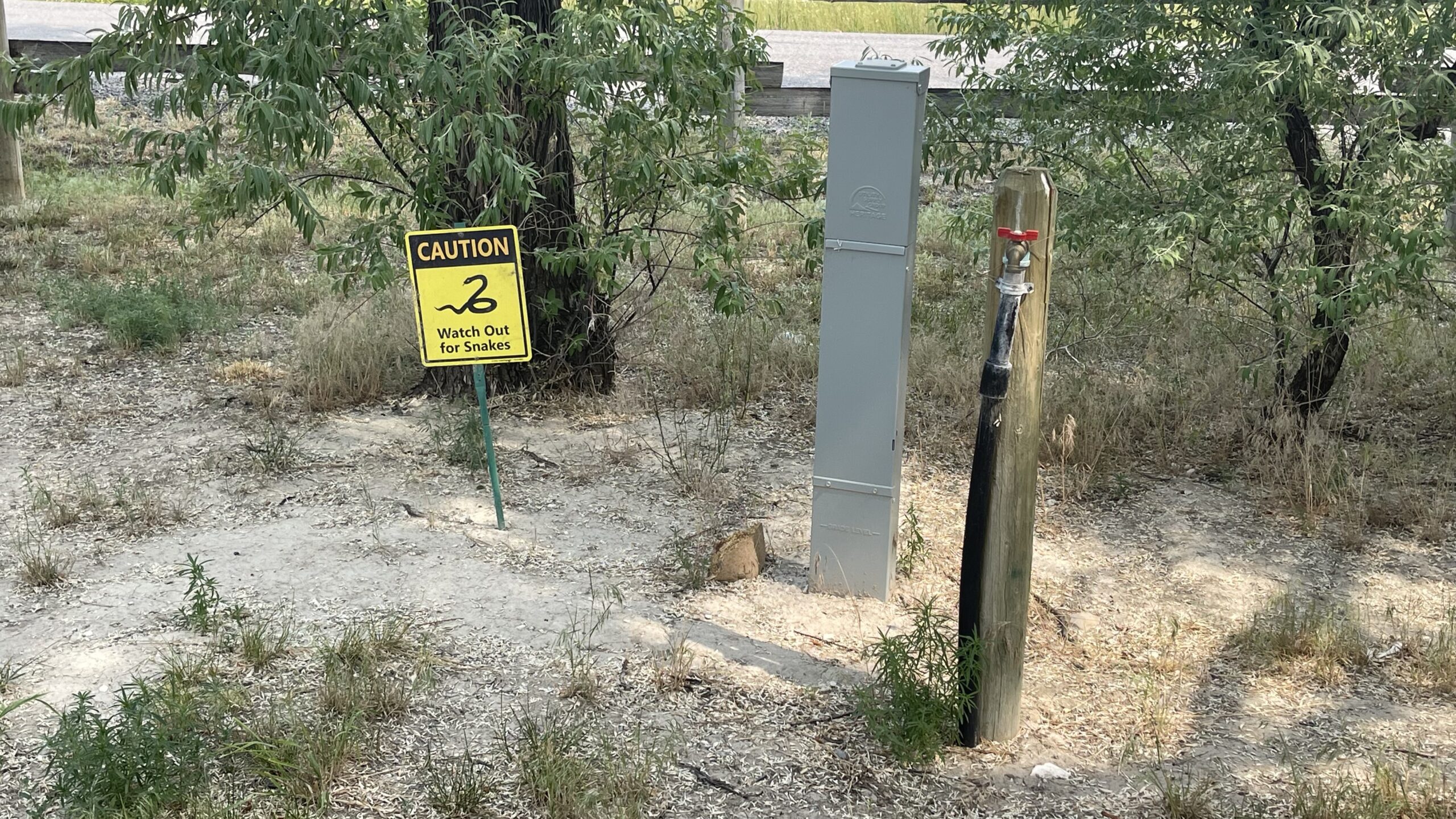
Well, ah, ok 
Cody, WY
It was 25 years ago, almost to the day, that I was last in Cody, WY. It was a family cross country pop-up camping trip out here to the west to see Yellowstone. We stayed here in Cody back then, as a gateway to the National Park. I remember it being a very fun experience, so what the hell, might as well stay here again. The memories are faint, but I do remember going to the rodeo back then, and of course visiting Yellowstone. This trip was pretty much the same itinerary as back then, with a few Roadside items thrown in for good measure.
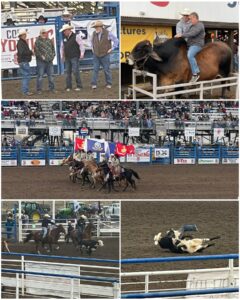 As I mentioned, I do remember going to the rodeo back then, but I don’t believe it was the same famed event as this time. Every year over the 4th of July holiday, Cody is host to professional rodeo riders who participate in their annual rodeo extravaganza known as the Stampede. It’s a huge event requiring tickets to be purchased way in advance (I was told about this when I made my campground reservations back in Apr, so I got myself a ticket back then). There was your typical trick riding, bull riding, and cow rangling that you would expect to see at a rodeo – only all the participants are not local cowboys and cowgirls, but rather professional riders from all over the country. They are scored over the multi-day event to see who comes out ahead and wins the prize money. There were even celebrities there including Daniel Lawrence Whitney, aka Larry the Cable Guy (at left, top left, second from the left) who apparently is a huge rodeo fan (Git-R-Done!). It was a fun event despite it being cold and rainy that evening.
As I mentioned, I do remember going to the rodeo back then, but I don’t believe it was the same famed event as this time. Every year over the 4th of July holiday, Cody is host to professional rodeo riders who participate in their annual rodeo extravaganza known as the Stampede. It’s a huge event requiring tickets to be purchased way in advance (I was told about this when I made my campground reservations back in Apr, so I got myself a ticket back then). There was your typical trick riding, bull riding, and cow rangling that you would expect to see at a rodeo – only all the participants are not local cowboys and cowgirls, but rather professional riders from all over the country. They are scored over the multi-day event to see who comes out ahead and wins the prize money. There were even celebrities there including Daniel Lawrence Whitney, aka Larry the Cable Guy (at left, top left, second from the left) who apparently is a huge rodeo fan (Git-R-Done!). It was a fun event despite it being cold and rainy that evening.
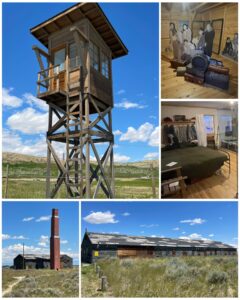 Next I paid a visit to nearby Heart Mountain – home to one of ten Japanese concentration camps from World War II. It was Feb 19, 1942, six weeks after the Japanese attack on Pearl Harbor, when President Franklin Roosevelt issued executive order 9066 requiring the removal and incarceration of everyone of Japanese ancestry living on the West Coast. In all, 120,000 people were imprisoned, over 14,000 here at the Heart Mountain complex. Each family was given one room to live in – some as small as 16×20 (at right, top and center right). Bathrooms were located in latrine buildings – shared by upwards of 250 people. Food was served in communal mess halls. Very little remains of the camp other than a guard tower, a couple of original and dreadfully deteriorated barracks (at right, bottom right), and the red brick chimney that once served the hospital’s boiler room. The interpretive center was filled with pictures and artifacts that told stories of this tragic time in our history. During their confinement, the incarcerees did whatever they could to maintain a normal semblance of life. They established schools, a hospital, and even fire and police departments. They even completed an abandoned irrigation canal which allowed them to farm the area around the camp. In early 1945, residents were told they could return home and our generous government gave them each $25 and a one-way bus ticket to their chosen destination. However, many had lost everything and had no home upon which to return. Definately a solemn and thoughtful place to visit.
Next I paid a visit to nearby Heart Mountain – home to one of ten Japanese concentration camps from World War II. It was Feb 19, 1942, six weeks after the Japanese attack on Pearl Harbor, when President Franklin Roosevelt issued executive order 9066 requiring the removal and incarceration of everyone of Japanese ancestry living on the West Coast. In all, 120,000 people were imprisoned, over 14,000 here at the Heart Mountain complex. Each family was given one room to live in – some as small as 16×20 (at right, top and center right). Bathrooms were located in latrine buildings – shared by upwards of 250 people. Food was served in communal mess halls. Very little remains of the camp other than a guard tower, a couple of original and dreadfully deteriorated barracks (at right, bottom right), and the red brick chimney that once served the hospital’s boiler room. The interpretive center was filled with pictures and artifacts that told stories of this tragic time in our history. During their confinement, the incarcerees did whatever they could to maintain a normal semblance of life. They established schools, a hospital, and even fire and police departments. They even completed an abandoned irrigation canal which allowed them to farm the area around the camp. In early 1945, residents were told they could return home and our generous government gave them each $25 and a one-way bus ticket to their chosen destination. However, many had lost everything and had no home upon which to return. Definately a solemn and thoughtful place to visit.
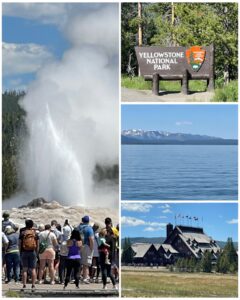 And then there’s this gem of a place – Yellowstone National Park. Spanning almost 3,500 square miles, Yellowstone is comprised of lakes, canyons, rivers, and mountain ranges, and is centered over the Yellowstone Caldera – the largest super volcano on the continent. Well over half of the world’s geysers and hydrothermal features are in Yellowstone. It became a National Park by President Ulysses S. Grant on March 1, 1872, and has the distinction of being the very first National Park in the country. I arrived just around lunch time, and based on the Old Faithful eruption schedule, I’d have time to get some food. So, I had lunch in the famous and very beautiful Yellowstone Lodge. And sure enough, soon after I finished and got myself to a viewing spot, Old Faithful blew its stack and provided a show like no other. The geyser lasted several minutes spewing thousands of gallons of steaming hot water up 100 feet or more into the air. It was a wonderful site to see.
And then there’s this gem of a place – Yellowstone National Park. Spanning almost 3,500 square miles, Yellowstone is comprised of lakes, canyons, rivers, and mountain ranges, and is centered over the Yellowstone Caldera – the largest super volcano on the continent. Well over half of the world’s geysers and hydrothermal features are in Yellowstone. It became a National Park by President Ulysses S. Grant on March 1, 1872, and has the distinction of being the very first National Park in the country. I arrived just around lunch time, and based on the Old Faithful eruption schedule, I’d have time to get some food. So, I had lunch in the famous and very beautiful Yellowstone Lodge. And sure enough, soon after I finished and got myself to a viewing spot, Old Faithful blew its stack and provided a show like no other. The geyser lasted several minutes spewing thousands of gallons of steaming hot water up 100 feet or more into the air. It was a wonderful site to see.
 From there, I would take a walk over to the geothermal area to see all the pots and pools of bubbling water that also filled the air with the beautiful aroma of hydrogen sulfide – the stench of rotten eggs. I remembered from my visit 25 years prior the wooden walkway that meandered through the area taking you past all of the colorful pools of hot bubbly water, with signs throughout warning visitors to remain on the wooden path to avoid being scorched and burned. I don’t know if it was my imagination or rather my lack of a good memory, but I seemed to recall back during my first visit that this area had much larger pools, and in some cases way more colorful. It’s possible the geothermal nature of the area has changed over the past two and a half decades, or perhaps I’m just remembering it wrong. Who knows! But, it was no less beautiful and truly unique among our many national treasures.
From there, I would take a walk over to the geothermal area to see all the pots and pools of bubbling water that also filled the air with the beautiful aroma of hydrogen sulfide – the stench of rotten eggs. I remembered from my visit 25 years prior the wooden walkway that meandered through the area taking you past all of the colorful pools of hot bubbly water, with signs throughout warning visitors to remain on the wooden path to avoid being scorched and burned. I don’t know if it was my imagination or rather my lack of a good memory, but I seemed to recall back during my first visit that this area had much larger pools, and in some cases way more colorful. It’s possible the geothermal nature of the area has changed over the past two and a half decades, or perhaps I’m just remembering it wrong. Who knows! But, it was no less beautiful and truly unique among our many national treasures.
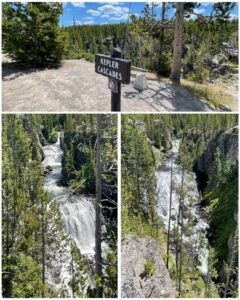 I then took a drive through Yellowstone to check out some of the other areas of interest. One in particular was Kepler Cascades. Located about two and a half miles south of Old Faithful Village, this cascading waterfall on the Firehole River drops about 150 feet across multiple drops – the longest of which is 50 feet. The cascades was named by park superintendent Philetus Norris in 1881 for Kepler Hoyt – the 12 year old son of Wyoming’s governor John Wesley Hoyt, who were there visiting the park at the time. It’s a beautiful site to see.
I then took a drive through Yellowstone to check out some of the other areas of interest. One in particular was Kepler Cascades. Located about two and a half miles south of Old Faithful Village, this cascading waterfall on the Firehole River drops about 150 feet across multiple drops – the longest of which is 50 feet. The cascades was named by park superintendent Philetus Norris in 1881 for Kepler Hoyt – the 12 year old son of Wyoming’s governor John Wesley Hoyt, who were there visiting the park at the time. It’s a beautiful site to see.
As usual, between the pictures and video that I took with my phone, along with the dash camera video from the truck, I was able to put this little show together that represents most of what I saw during this wonderful visit. I hope you enjoy it!
Footnote: Just as I was about to publish this blog edition, a news article came out about a pool in the geothermal area that exploded into a dangerous geyser on Tue July 23 – just two weeks after I was there. It was reported that the last time there was a geyser in this area was about 15 years ago in 2009. The park sustained damage to the wooden boardwalk, but thankfully there were no reported injuries. A news account and videos of the incident can be found HERE. Geez – sure glad I missed that one!
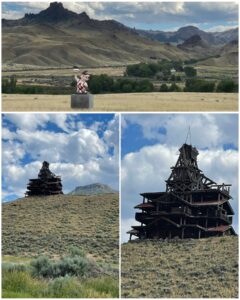 There were a couple of unusual Roadside oddities along the road leading into Yellowstone from Cody, so of course I had to check them out. First up, in the middle of a large fenced in field stands this Bob’s Big Boy statue mounted on a concrete pedestal. Apparently it just appeared in 2013, and there doesn’t seem to be an explanation as to why it is there. I suppose just something interesting to see along this otherwise sparsely inhabited roadway. Speaking of interesting, also along this road is this place – known as the Smith Mansion. This 5-story 77 ft tall architectural masterpiece is the work of Francis Lee Smith. Lee labored on this log house as a side project for 22 years, hauling logs from nearby Rattlesnake Mountain to hand build this crazy structure. What started out as a hobby evolved into an obsession costing Lee not only his marriage, but also his life. In April of 1992, Lee was alone on a high balcony when a falling piece of lumber struck him causing him to fall to the ground 20 feet below. His body was discovered two days later. Ownership of the home transferred to his daughter Sunny who attempted several fund raisers to secure money to restore the home. But alas, it remained empty and abandoned for decades. Finally, in 2019 Sunny decided to sell the property and listed it with a real estate company. The listing company created a cool video (HERE) that was used to advertise the unique property. It sold quickly and was purchased by a local business that owns an RV park and several lodging facilities in the area. The purchase price was not disclosed, but it is estimated to have fetched somewhere around a half million for the structure and its surrounding 5 acres of land. No news yet as to what they plan to do with the property, so the historical and mystique qualities of it remain.
There were a couple of unusual Roadside oddities along the road leading into Yellowstone from Cody, so of course I had to check them out. First up, in the middle of a large fenced in field stands this Bob’s Big Boy statue mounted on a concrete pedestal. Apparently it just appeared in 2013, and there doesn’t seem to be an explanation as to why it is there. I suppose just something interesting to see along this otherwise sparsely inhabited roadway. Speaking of interesting, also along this road is this place – known as the Smith Mansion. This 5-story 77 ft tall architectural masterpiece is the work of Francis Lee Smith. Lee labored on this log house as a side project for 22 years, hauling logs from nearby Rattlesnake Mountain to hand build this crazy structure. What started out as a hobby evolved into an obsession costing Lee not only his marriage, but also his life. In April of 1992, Lee was alone on a high balcony when a falling piece of lumber struck him causing him to fall to the ground 20 feet below. His body was discovered two days later. Ownership of the home transferred to his daughter Sunny who attempted several fund raisers to secure money to restore the home. But alas, it remained empty and abandoned for decades. Finally, in 2019 Sunny decided to sell the property and listed it with a real estate company. The listing company created a cool video (HERE) that was used to advertise the unique property. It sold quickly and was purchased by a local business that owns an RV park and several lodging facilities in the area. The purchase price was not disclosed, but it is estimated to have fetched somewhere around a half million for the structure and its surrounding 5 acres of land. No news yet as to what they plan to do with the property, so the historical and mystique qualities of it remain.
Hardin, MT
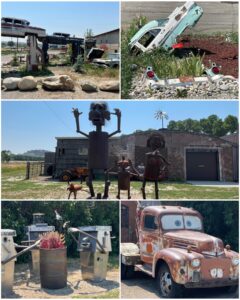 My next stop would take me, for the first time in my life, into the state of Montana. First up is Hardin – a sleepy little town 40 miles east of Billings with approximately 3,800 residents. From a Roadside perspective, there was nothing to see here. So I ventured off towards Billings and beyond to check out some interesting places. In Edgar, MT I checked out a place called Fordhenge. Inspired by his visit to Carhenge in Nebraska, Greg Nelson used 16 junker Fords from the 1950s and 1960s to create his Fordhenge (at left, top). It was actually pretty well done! In nearby Joliet, was a collection of metal art by artist Charles Ringer. What started out as just the 18 foot ‘The Creature” – made of welded steel pipe, cable, and a water tank, has now apparently grown to a full family with a wife, kids, and even a dog. A group of old gas pumps huddling around a fire can also adorns the grounds. Last no collection would be complete without a Mater truck look alike from the movie Cars. Nice yard art!
My next stop would take me, for the first time in my life, into the state of Montana. First up is Hardin – a sleepy little town 40 miles east of Billings with approximately 3,800 residents. From a Roadside perspective, there was nothing to see here. So I ventured off towards Billings and beyond to check out some interesting places. In Edgar, MT I checked out a place called Fordhenge. Inspired by his visit to Carhenge in Nebraska, Greg Nelson used 16 junker Fords from the 1950s and 1960s to create his Fordhenge (at left, top). It was actually pretty well done! In nearby Joliet, was a collection of metal art by artist Charles Ringer. What started out as just the 18 foot ‘The Creature” – made of welded steel pipe, cable, and a water tank, has now apparently grown to a full family with a wife, kids, and even a dog. A group of old gas pumps huddling around a fire can also adorns the grounds. Last no collection would be complete without a Mater truck look alike from the movie Cars. Nice yard art!
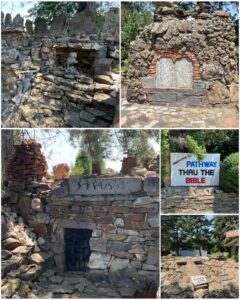 Also in Joliet was this cool place. Known as the Pathway Through the Bible, it’s a collection of stone structures and grotto art depicting scenes from the Bible. This place was amazing – easily over 30 individual creations. It was built by Adolph Land, along with his wife Helen and friends and family. He started in the early 1960s and continued until his death in 1984. The stone works showcase everything from the creation of Genesis, to Adam and Eve, Noah’s Ark, all through the Crucifixion and ending with an empty tomb. Following Adolph’s death, Helen continued the maintenance until it became too much for her. She did a house swap with a young couple from Billings who wanted to move to a more rural area to raise their family. They have been the caretakers since, and now themselves are starting to think about handing over the reins as they reach their retirement years. Hopefully they find a new family who can remain watch over this gem of a Roadside stop.
Also in Joliet was this cool place. Known as the Pathway Through the Bible, it’s a collection of stone structures and grotto art depicting scenes from the Bible. This place was amazing – easily over 30 individual creations. It was built by Adolph Land, along with his wife Helen and friends and family. He started in the early 1960s and continued until his death in 1984. The stone works showcase everything from the creation of Genesis, to Adam and Eve, Noah’s Ark, all through the Crucifixion and ending with an empty tomb. Following Adolph’s death, Helen continued the maintenance until it became too much for her. She did a house swap with a young couple from Billings who wanted to move to a more rural area to raise their family. They have been the caretakers since, and now themselves are starting to think about handing over the reins as they reach their retirement years. Hopefully they find a new family who can remain watch over this gem of a Roadside stop.
I had several more stops on my list – mostly in Billings, but alas I started feeling a bit under the weather and instead decided to head home to the comfort of the RV. Being that I only had this one day to explore, I guess I’ll have to make a return trip to this area some day to see those stops I missed.
Three Forks, MT
My next venture within Montana is the town known as Three Forks. Another rural community with a population just under 2,000. Three Forks got its name as it is nearby the point where the Jefferson, Madison, and Gallatin rivers converge to form the Missouri River – and hence the town’s designation as the birthplace of the Missouri River. Once again there was not much to see here in town, but Bozeman to the east and Butte to the west offered plenty of places to explore.
 So off to Butte I went. Located 50 miles west of Three Forks, and Montana’s fifth largest city with a population of 35,000, Butte has a long history as a mining town. So it is no surprise that my first stop would take me to the World Museum of Mining. Featuring a collection of old buildings to recreate a mining town, a large collection of rocks and minerals, an actual mining elevator, and even a tour of an underground mine (something I skipped in favor of self preservation). These all provided an excellent overview of the mining industry and what life was like back in the mining days. Then, in the downtown is the Dumas Brothel house (at left, bottom right) – the last remaining building in what was once the two-block red light district. Beginning in the 1890s, this place reportedly provided comfort services to miners until its closure in 1982 – making it America’s longest running house of ill repute. Wow, now thats a long running business!
So off to Butte I went. Located 50 miles west of Three Forks, and Montana’s fifth largest city with a population of 35,000, Butte has a long history as a mining town. So it is no surprise that my first stop would take me to the World Museum of Mining. Featuring a collection of old buildings to recreate a mining town, a large collection of rocks and minerals, an actual mining elevator, and even a tour of an underground mine (something I skipped in favor of self preservation). These all provided an excellent overview of the mining industry and what life was like back in the mining days. Then, in the downtown is the Dumas Brothel house (at left, bottom right) – the last remaining building in what was once the two-block red light district. Beginning in the 1890s, this place reportedly provided comfort services to miners until its closure in 1982 – making it America’s longest running house of ill repute. Wow, now thats a long running business!
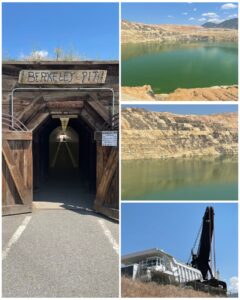 The other mining related venue I visited in Butte is reportedly known to be the most toxic body of water in the country. Originally an open pit copper mine from 1955, this one mile long by 1/2 mile wide by 1,800 feet deep (deeper than any of the Great Lakes) hole in the ground was closed for mining in 1982. Naturally flowing ground water has since filled the pit, and through a process known as acid rock drainage, it’s been contaminated with heavy metals such as copper, arsenic, cadmium, zinc, and sulfuric acid. Definately not a place to go for a swim! In fact, the 40 billion gallons of waste water is so deadly that in 1995 it killed over 300 snow geese that mistakenly landed on it. Then again in 2016, some 10,000 snow geese landed on the pond, killing thousands of them. In order to maintain the ever growing water levels from seeping into a nearby creek and other local water sources, a treatment plant was opened and in continuous operation since 2019. Also noise and other deterrent devices have been installed around the area to discourage birds and other animals from interacting with the toxic water. Certainly one of the most unusual Roadside attractions I’ve been to.
The other mining related venue I visited in Butte is reportedly known to be the most toxic body of water in the country. Originally an open pit copper mine from 1955, this one mile long by 1/2 mile wide by 1,800 feet deep (deeper than any of the Great Lakes) hole in the ground was closed for mining in 1982. Naturally flowing ground water has since filled the pit, and through a process known as acid rock drainage, it’s been contaminated with heavy metals such as copper, arsenic, cadmium, zinc, and sulfuric acid. Definately not a place to go for a swim! In fact, the 40 billion gallons of waste water is so deadly that in 1995 it killed over 300 snow geese that mistakenly landed on it. Then again in 2016, some 10,000 snow geese landed on the pond, killing thousands of them. In order to maintain the ever growing water levels from seeping into a nearby creek and other local water sources, a treatment plant was opened and in continuous operation since 2019. Also noise and other deterrent devices have been installed around the area to discourage birds and other animals from interacting with the toxic water. Certainly one of the most unusual Roadside attractions I’ve been to.
Besides all the mining history, Butte is also known as the birthplace and hometown of famed motorcycle stunt performer Robert Craig Knievel – or as he’s better known, Evel Knievel. Evel was born here in Butte on Oct 17, 1938, and upon his death on Nov 30, 2007, was buried here in Butte along side his Knievel family at Mountainview Cemetery. An interesting story of his early life tells us that he left Butte High School after his sophomore year and took a job with the Anaconda Mining Company as a copper mine diamond drill operator. He was later promoted to work above ground as a driver of a large earth mover, but was fired when he did a wheelie with the earth mover and crashed into Buttes’ main power lines putting the entire town into darkness for several hours. Sure does sound like something he would do! Next to his gravesite in the town cemetery is his son Robbie, who had followed in his dad’s motorcycle stunt lifestyle, but passed away in 2023 from pancreatic cancer. The headstones are nicely done with pictures and passages representative of their lives.
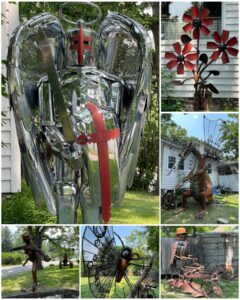 Next, I headed 35 miles to the east to the town of Bozeman. Having a population over 53,000, Bozeman is the fourth largest city in Montana. Known as the Valley of the Flowers, the natural beauty of the area and lots of recreational opportunities including skiing, makes this one of the fastest growing city’s in Montana. I could not agree more – as I drove around touring the town, I found it to be a very pleasant looking place to live. The first place I stopped to check out was this collection of yard art produced from junk metal by artist Ted Koterwas. As luck would have it, Mr. Koterwas, a senior man likely to be in his 70s or more, happened to be puttering around in his backyard. He noticed me wandering around taking pictures of his work from the vantage point of the street and sidewalk, and graciously invited me into his yard for a closer look. I chatted with him for several minutes and he told me about the making of his last creature, the giant 10+ foot tall dragon (at right, center right), which took him upwards of 4 years to complete and almost killed him with the effort. Each scale was hand cut and welded to form the body. Just amazing! His work is beautiful and clearly represents the many artistic talents he possesses. The all aluminum piece he calls the Guardian Angel (at right, top left), is made mostly from chrome car bumpers. I asked about getting him in one of the pictures, but he preferred not. I really appreciate his welcoming hospitality.
Next, I headed 35 miles to the east to the town of Bozeman. Having a population over 53,000, Bozeman is the fourth largest city in Montana. Known as the Valley of the Flowers, the natural beauty of the area and lots of recreational opportunities including skiing, makes this one of the fastest growing city’s in Montana. I could not agree more – as I drove around touring the town, I found it to be a very pleasant looking place to live. The first place I stopped to check out was this collection of yard art produced from junk metal by artist Ted Koterwas. As luck would have it, Mr. Koterwas, a senior man likely to be in his 70s or more, happened to be puttering around in his backyard. He noticed me wandering around taking pictures of his work from the vantage point of the street and sidewalk, and graciously invited me into his yard for a closer look. I chatted with him for several minutes and he told me about the making of his last creature, the giant 10+ foot tall dragon (at right, center right), which took him upwards of 4 years to complete and almost killed him with the effort. Each scale was hand cut and welded to form the body. Just amazing! His work is beautiful and clearly represents the many artistic talents he possesses. The all aluminum piece he calls the Guardian Angel (at right, top left), is made mostly from chrome car bumpers. I asked about getting him in one of the pictures, but he preferred not. I really appreciate his welcoming hospitality.
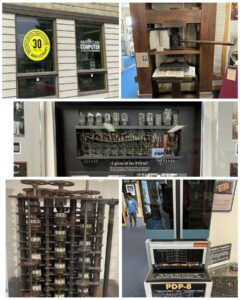 My next and final stop in Bozeman was one I had been so looking forward to as soon as I had discovered it. Akin to a kid in a candy store, my visiting a computer museum is nothing short of exhilarating. The American Computer & Robotics Museum, founded in May 1990, claims to be the oldest continually operating museum of its kind in the world. I actually challenged them on that fact knowing that what was once The Computer Museum formed in 1975, and also known as the Boston Computer Museum (a place I had visited in the 90s), has evolved and now continues to operate in California as the Computer History Museum (CHM). I guess their position is that the change in name and location from Boston to Cali constitutes a break in operation. Oh well, we agree to disagree. But that fact aside, this was a pretty cool little museum, albeit nothing compared to the scale of CHM which houses the largest and most significant collection of computing artifacts in the world. Anyway, it was a fun several hours of exploring and reminiscing my own personal history of working with all sorts of computers – many of which now seem to have found themselves in a damn museum. Their collection started with an early Information Age device – the Gutenberg Press (at left, top right), to a Babbage Difference Engine (at left, bottom left), to an actual counter module from the original ENIAC (at left, center), to a complete DEC PDP-8 – the first successful desktop commercial minicomputer.
My next and final stop in Bozeman was one I had been so looking forward to as soon as I had discovered it. Akin to a kid in a candy store, my visiting a computer museum is nothing short of exhilarating. The American Computer & Robotics Museum, founded in May 1990, claims to be the oldest continually operating museum of its kind in the world. I actually challenged them on that fact knowing that what was once The Computer Museum formed in 1975, and also known as the Boston Computer Museum (a place I had visited in the 90s), has evolved and now continues to operate in California as the Computer History Museum (CHM). I guess their position is that the change in name and location from Boston to Cali constitutes a break in operation. Oh well, we agree to disagree. But that fact aside, this was a pretty cool little museum, albeit nothing compared to the scale of CHM which houses the largest and most significant collection of computing artifacts in the world. Anyway, it was a fun several hours of exploring and reminiscing my own personal history of working with all sorts of computers – many of which now seem to have found themselves in a damn museum. Their collection started with an early Information Age device – the Gutenberg Press (at left, top right), to a Babbage Difference Engine (at left, bottom left), to an actual counter module from the original ENIAC (at left, center), to a complete DEC PDP-8 – the first successful desktop commercial minicomputer.
 The museum goes on to showcase a collection of Apple devices – including a Wozniak autographed Apple-1 board, along with the lineage of Apple products introduced over the next several decades including a 20th Anniversary Macintosh from 1997 that I’d never seen (at right, top right). They also featured a number of other early personal computers including an Osborne 1 (I had one of those), an Altair 680, and an early model Commodore PET. An overall nice collection of many computers that I’ve known well and/or worked on in my computer career.
The museum goes on to showcase a collection of Apple devices – including a Wozniak autographed Apple-1 board, along with the lineage of Apple products introduced over the next several decades including a 20th Anniversary Macintosh from 1997 that I’d never seen (at right, top right). They also featured a number of other early personal computers including an Osborne 1 (I had one of those), an Altair 680, and an early model Commodore PET. An overall nice collection of many computers that I’ve known well and/or worked on in my computer career.
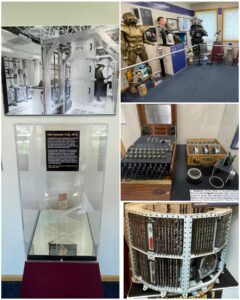 They also had an interesting collection of other historical pieces. Their collection of robots included a Robby the Robot replica from the 1956 movie Forbidden Planet, as well as a variety of what were to be personal home robots. An interesting piece I’d not seen before was a Minuteman 1 Missile flight computer from the early 1960s (at left, bottom right). Also not seen before was a Quantum Chip from an IBM Quantum Computer (at left, left). Last up on the historical train was an Enigma (at left, center right) – an encryption device used by the German forces in World War II, and which was the focus of Alan Turing who cracked the code with the Bombe (which was the subject of the movie The Imitation Game). Though this Enigma is not original but rather a replica, the box and gear wheels shown to the right in the picture are legit, and are actually on loan to this museum from the National Cryptologic Museum located around my old hometown area near Fort Meade, MD. All in all, this was an enjoyable trip down memory lane, and the introduction of a few new pieces of technology I’d not encountered before. So, well worth the trip!
They also had an interesting collection of other historical pieces. Their collection of robots included a Robby the Robot replica from the 1956 movie Forbidden Planet, as well as a variety of what were to be personal home robots. An interesting piece I’d not seen before was a Minuteman 1 Missile flight computer from the early 1960s (at left, bottom right). Also not seen before was a Quantum Chip from an IBM Quantum Computer (at left, left). Last up on the historical train was an Enigma (at left, center right) – an encryption device used by the German forces in World War II, and which was the focus of Alan Turing who cracked the code with the Bombe (which was the subject of the movie The Imitation Game). Though this Enigma is not original but rather a replica, the box and gear wheels shown to the right in the picture are legit, and are actually on loan to this museum from the National Cryptologic Museum located around my old hometown area near Fort Meade, MD. All in all, this was an enjoyable trip down memory lane, and the introduction of a few new pieces of technology I’d not encountered before. So, well worth the trip!
Final Thoughts
 Well, my return trip to Cody after 25 years, and my first introduction to some areas within Montana have all been a lot of fun. I look forward to continuing my trek up through Montana, then darting over to Idaho – another state I’ve not been to before. So, there should be lots of opportunity to explore and learn about these wonderful places. I’m now roughly 10 weeks into my 22-week summer adventure, and the time is going quickly. Overall, things continue to run smoothly. That is except that fact that Internet access in rural areas of Wyoming and Montana are slim pickings. I’ve had to drag out some of my WiFi and Celluler booster gear to help grab and enhance what little signals there are in this area. Fortunately, with that gear I’ve managed to successfully scrape together enough of a connection to at least keep my online addictions in check. I may have to make an investment in a Starlink system if I’m going to continue this rural exploration. Anyway, until next time, be well and safe travels!
Well, my return trip to Cody after 25 years, and my first introduction to some areas within Montana have all been a lot of fun. I look forward to continuing my trek up through Montana, then darting over to Idaho – another state I’ve not been to before. So, there should be lots of opportunity to explore and learn about these wonderful places. I’m now roughly 10 weeks into my 22-week summer adventure, and the time is going quickly. Overall, things continue to run smoothly. That is except that fact that Internet access in rural areas of Wyoming and Montana are slim pickings. I’ve had to drag out some of my WiFi and Celluler booster gear to help grab and enhance what little signals there are in this area. Fortunately, with that gear I’ve managed to successfully scrape together enough of a connection to at least keep my online addictions in check. I may have to make an investment in a Starlink system if I’m going to continue this rural exploration. Anyway, until next time, be well and safe travels!
I only show a sampling of my adventure pictures here in the blog, and do so mostly in collage format for brevity and ease of reading. If you want to view an album containing individual full fidelity and hi-res images of all my travel pictures related to this specific blog, click the image below. Enjoy!
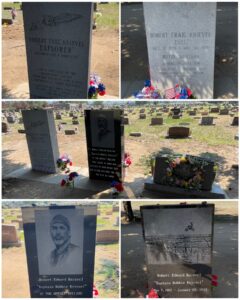

Looks like you had great weather while visiting Yellowstone. The video of the explosion was pretty cool. Luckly no one got hurt and someone was recording on their phone at the time. Keep on blogging, I enjoyed the video of your Yellowstone visit.
Thanks! Yea, that explosion was wicked. The weather has been pretty good. A week or so of hot temps, but now back in the high 70s and low 80s during the day, and 50s at night. Absolutely perfect!
I agree with your comment about the lack of color in the ‘pots’ area. I remember a riot of colors red, blue, yellow in profusion, along with the stink!
Rick
Ok, good that you think the colors are off too. Maybe I’m not going crazy after all.
Love Yellowstone!! The computer museum sounds really fun too!
Sorry for the delayed response, been a bit crazy here – all is well, just very hectic. I’m playing catch up today.
I’m playing catch up today. 
Starlink is pretty amazing – friends use it at their new house and love it.
Safe travels!
MG – There’s no timetable here to read these blogs. You enjoy them at your pace and as time permits. Besides, you are still working and not retired like me, so you don’t have as much free time as I. Anyway, Yellowstone was great, as was the computer museum. The geek in me sure did enjoy that! I’ll be in California next year and one of the things on my bucket list is to visit the computer museum there – reportedly the world’s largest and most comprehensive. That’s gonna be epic! Hope all is well with you!